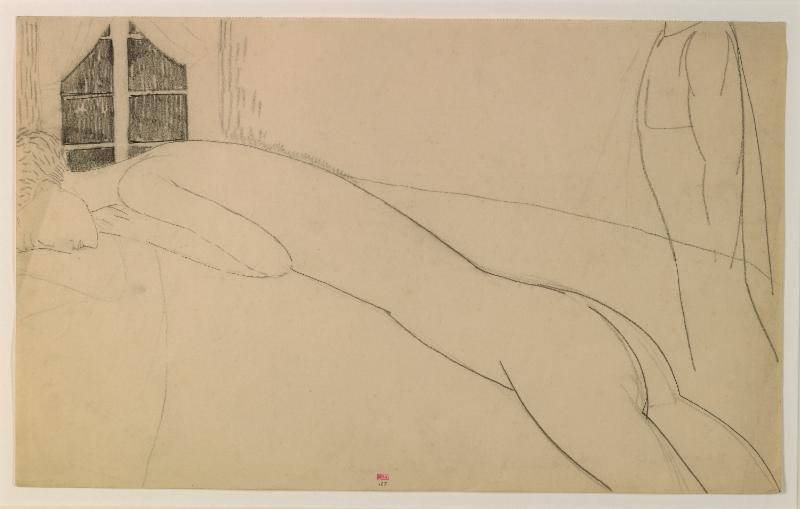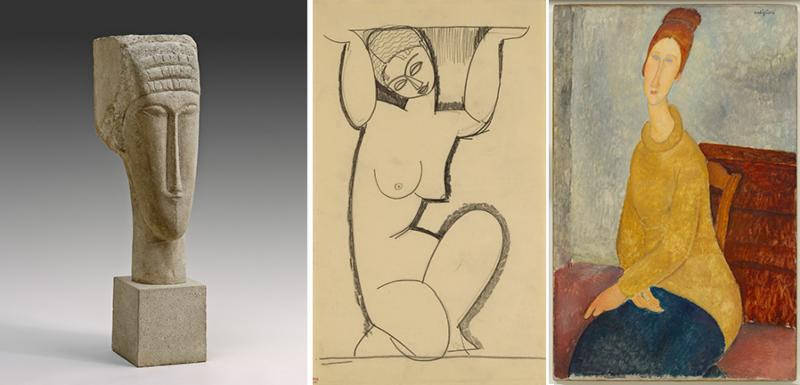Modigliani Unmasked
The Jewish Museum presents Modigliani Unmasked, the first exhibition in the United States to focus on Amedeo Modigliani's early work made in the years after he arrived in Paris in 1906. The exhibition puts a spotlight on Modigliani's drawings, with a large selection acquired directly from the artist by Dr. Paul Alexandre, his close friend and first patron.
The drawings from the Alexandre collection, many being shown for the first time in the United States, as well as other drawings from collections around the world and a selection of Modigliani's paintings and sculptures, illuminate how the artist's heritage as an Italian Sephardic Jew is pivotal to understanding his artistic output. The exhibition is on view at the Jewish Museum from September 15, 2017 through February 4, 2018.
Modigliani Unmasked considers the celebrated artist, Amedeo Modigliani (Italian, 1884-1920), shortly after he arrived in Paris in 1906, when the city was still roiling with anti-Semitism after the long-running tumult of the Dreyfus Affair and the influx of foreign emigres. An Italian Sephardic Jew with a French mother and a classical education, Modigliani was the embodiment of cultural heterogeneity.
When he moved to Paris, he came up against the idea of racial purity in French culture - in Italy, he did not feel ostracized for being Jewish. His Latin looks and fluency in French could have easily helped him to assimilate. Instead, his outsider status often compelled him to introduce himself with the words, "My name is Modigliani. I am Jewish." As a form of protest, he refused to assimilate, declaring himself as "other." The exhibition shows that Modigliani's art cannot be fully understood without acknowledging the ways the artist responded to the social realities that he confronted in the unprecedented artistic melting pot of Paris.
In these years prior to World War I, Modigliani largely stopped painting in order to develop his conceptual and pictorial ideas through drawing and sculpture. The works in the exhibition reveal the emerging artist himself, enmeshed in his own particular identity quandary, struggling to discover what portraiture might mean in a modern world of racial complexity.
Modigliani Unmasked is arranged thematically, and includes approximately 130 drawings, 12 paintings, and seven sculptures by the artist. Modigliani's art is complemented by work representative of the various multicultural influences - African, Asian, Greek, Egyptian, and Khmer - that inspired the young artist during this lesser-known, early period.
When he arrived in Paris, Modigliani - still virtually unknown - met Dr. Alexandre, a young physician. Alexandre amassed some 450 drawings directly from the artist and commissioned a number of portraits. The exhibition includes a selection of drawings depicting Dr. Alexandre, as well as a mysterious, unfinished portrait never seen before in the United States. Probably painted around 1913, it is a stylistic anomaly withinModigliani's oeuvre, more sketchy and gestural than his typical portraits.
Modigliani would visit museums in Paris, including the Louvre and the Musée du Trocadéro, and was mesmerized by the nonwestern art. Unlike most of his contemporaries in the French vanguard, who appropriated such works expressionistically as an abstracted distortion of the human form, Modigliani's manner of using such stylized effects was far more respectful. The influence of masks in particular is clearly visible in the many drawings and sculptures in the exhibition.
Prominent in the Alexandre collection are the stylized drawings related to sculptures. Produced between 1909 and 1914, this body of work constitutes a distinct category within the artist's oeuvre and reveals his ongoing preoccupation with identity. Particularly noticeable is his obsessive examination of physiognomy. When seen together, his repeated images of heads and faces reveal minute, calculated variations in the eyes, noses, and mouths. As seen in the exhibition, this group of drawings offer a nuanced commentary on the underlying issue of aesthetics as it relates to race.
In 1911, Modigliani began to explore a motif borrowed from ancient art, the caryatid, and a selection of these drawings is included in the exhibition. While in classical art the caryatid is usually a woman, his are male, female, or of ambiguous gender. He also incorporated elements derived from Egyptian art, as well as ancient South and Southeastern Asian sources such as facial features, postures, and tattoos.
The exhibition also includes a selection of life studies and female nudes. Among these are of the Russian poet Anna Akhmatova, whom the artist met in 1910. Her exotic presence inspired Modigliani to introduce her to Egyptian art. The influences he drew from Egyptian art, such as the attenuation of the figure and the angularity of form, can be seen in the drawings he did of her.
Modigliani's fondness for performance, including theater, street entertainment, and the circus, is reflected in numerous early drawings, often sketched from a blend of life and imagination. The exhibition includes his drawings of the Commedia dell'Arte character, Columbine, as well as circus performers. Many of these works - like others in the exhibition - reveal the acuity of his psychological awareness, which had the effect of transforming simple sketches into portraits.
Modigliani Unmasked is organized by Mason Klein, Senior Curator, The Jewish Museum. The exhibition was designed by Galia Solomonoff and Talene Montgomery of SAS/Solomonoff Architecture Studio.
----
Location: 1109 Fifth Avenue at 92nd Street, New York City
Hours: Saturday, Sunday, Monday, and Tuesday, 11 am to 5:45 pm; Thursday, 11 am to 8 pm; and Friday, 11 am to 4 pm.
Admission: $15.00 for adults, $12.00 for senior citizens, $7.50 for students, free for visitors 18 and under and Jewish Museum members. Pay What You Wish on Thursdays from 5 pm to 8 pm. Free on Saturdays.







































i-Italy
Facebook
Google+
This work may not be reproduced, in whole or in part, without prior written permission.
Questo lavoro non può essere riprodotto, in tutto o in parte, senza permesso scritto.